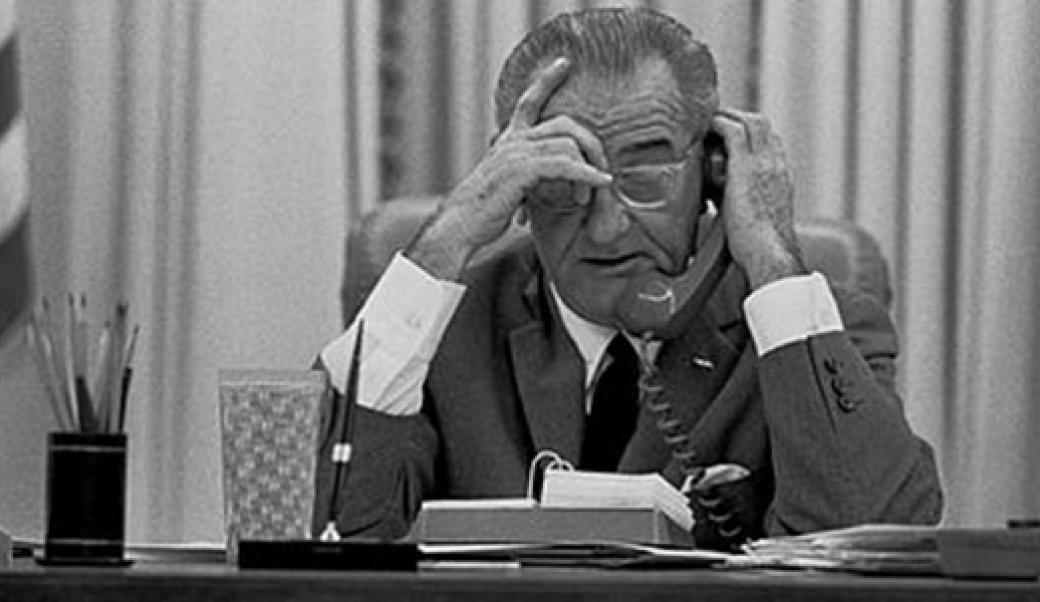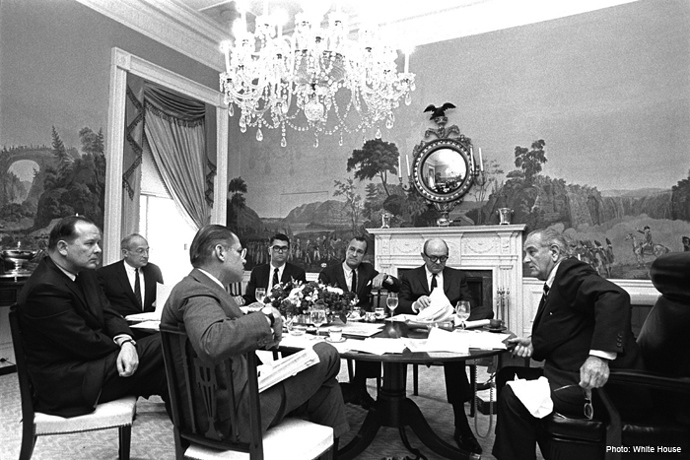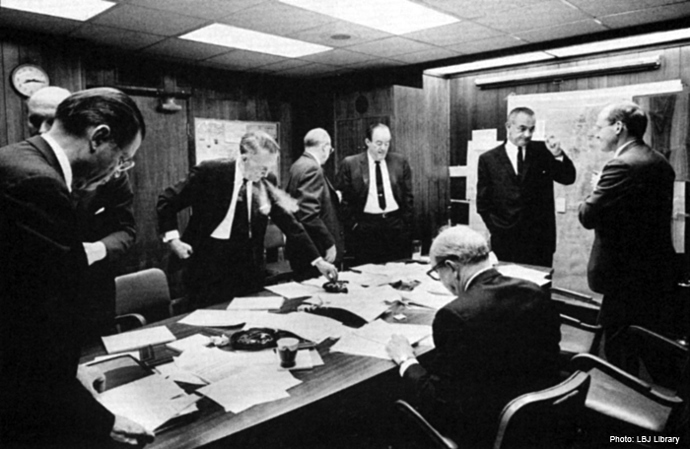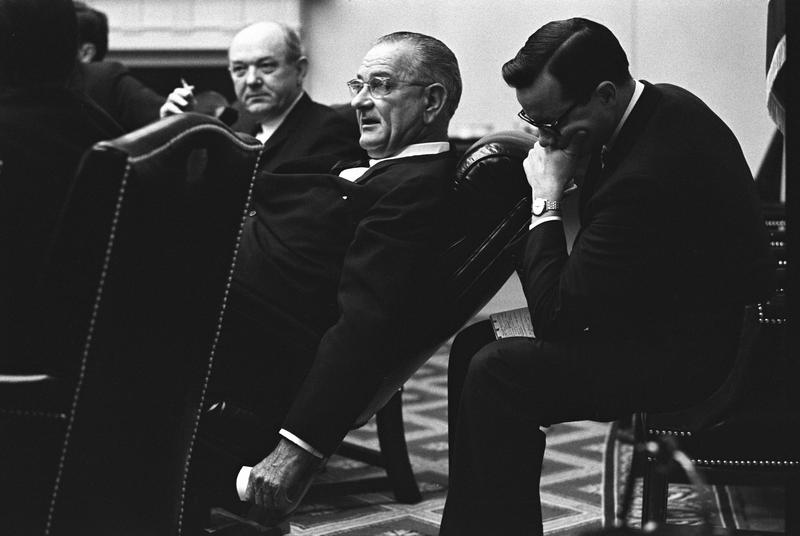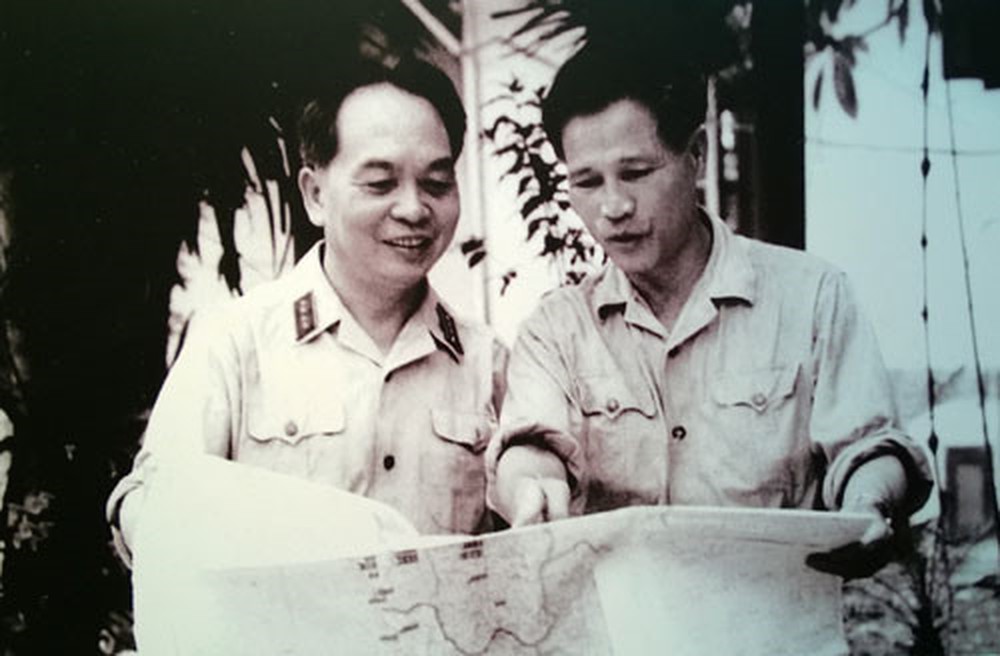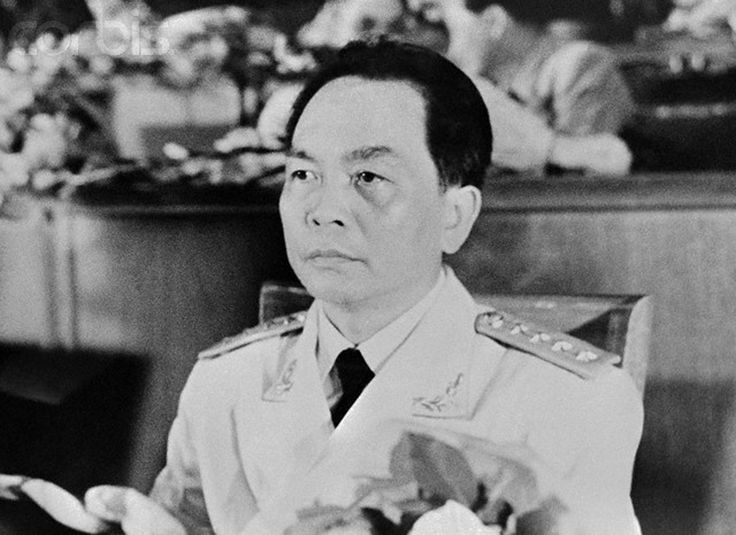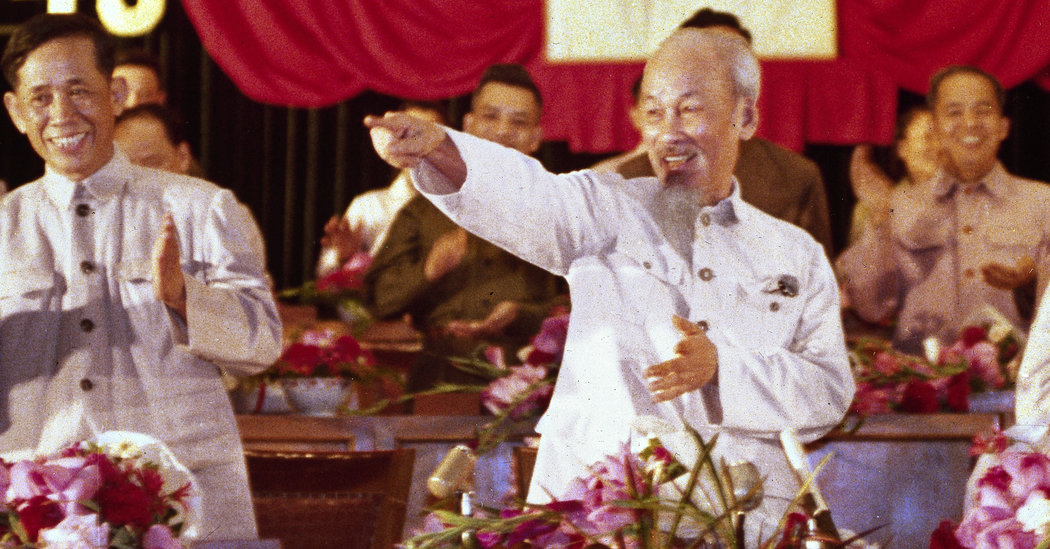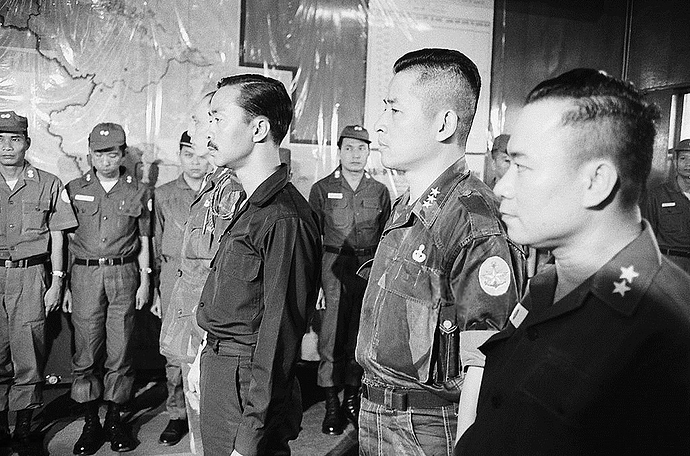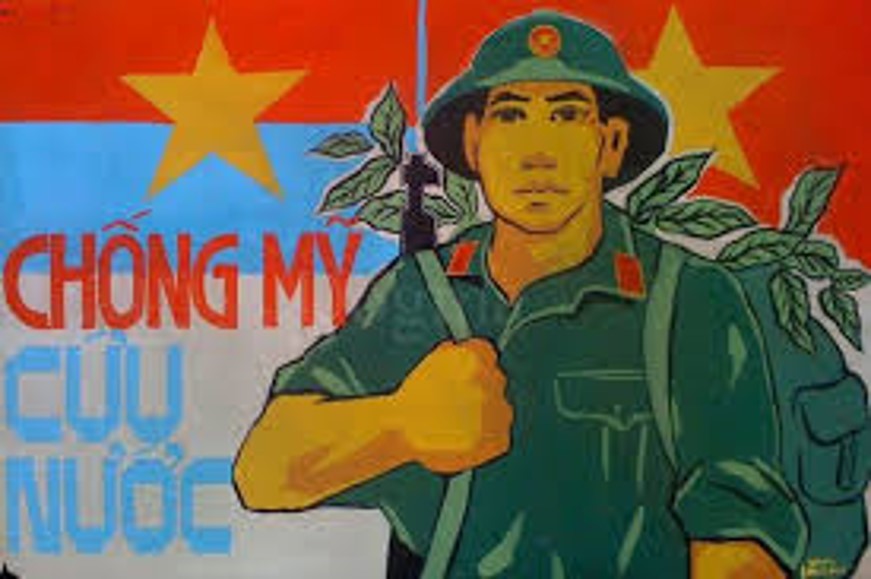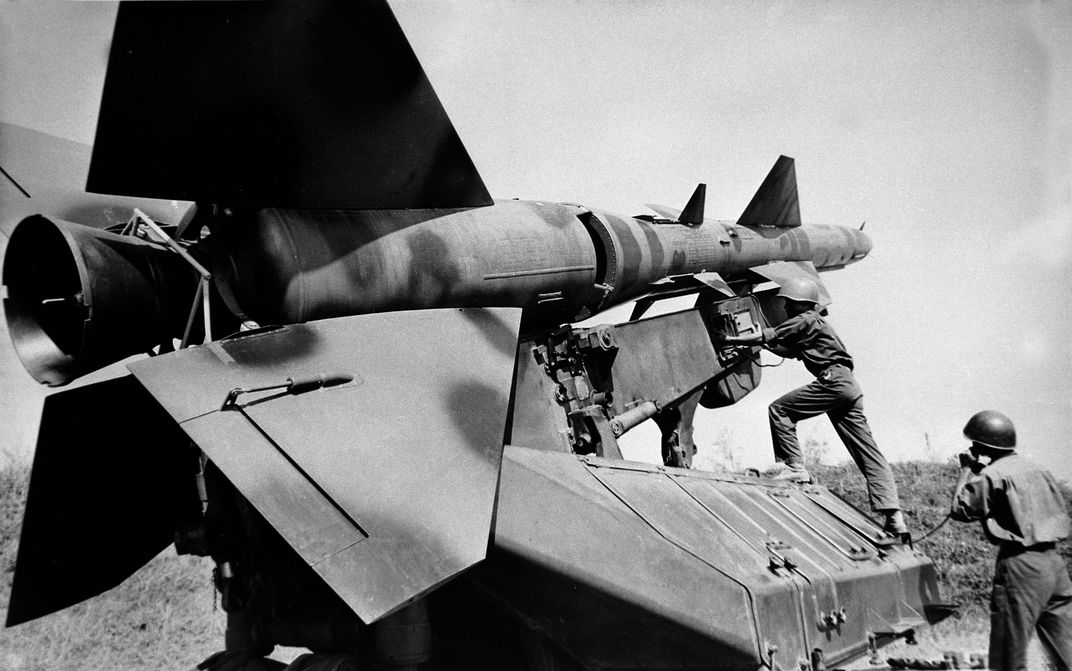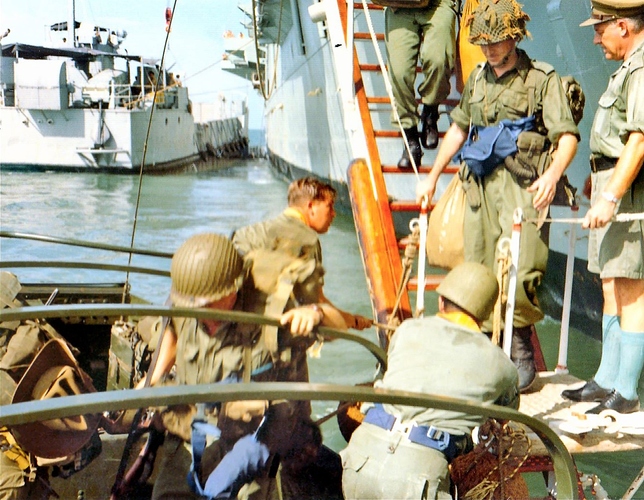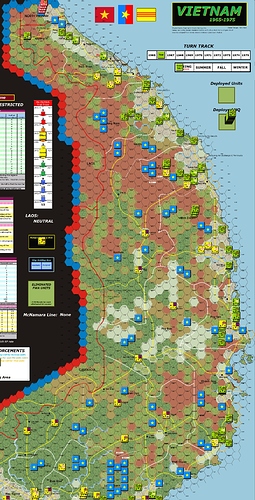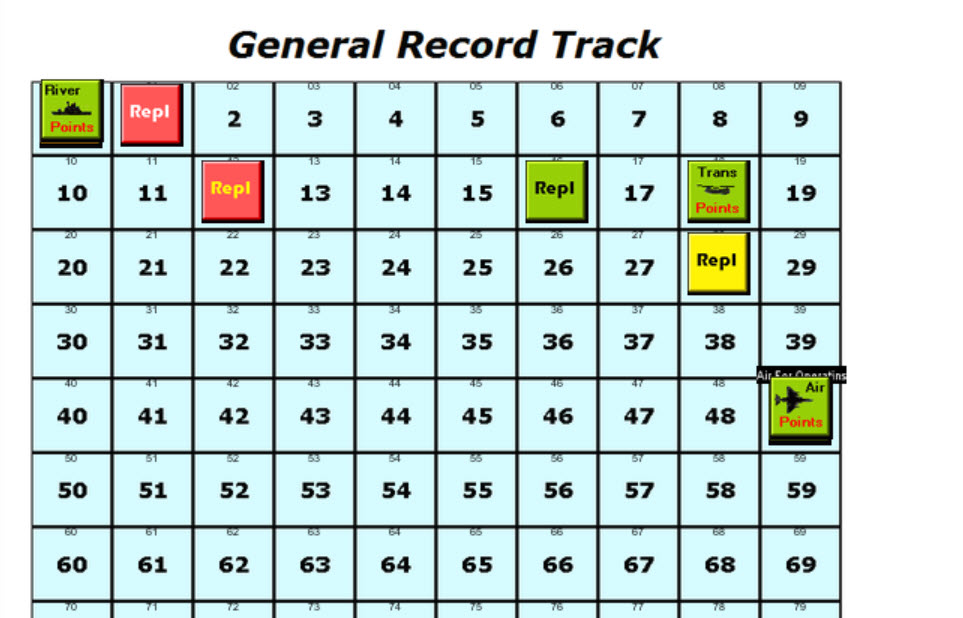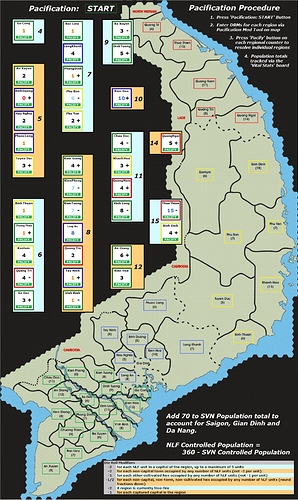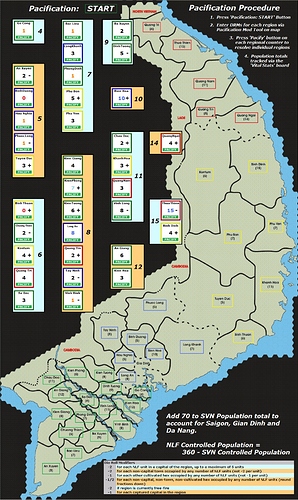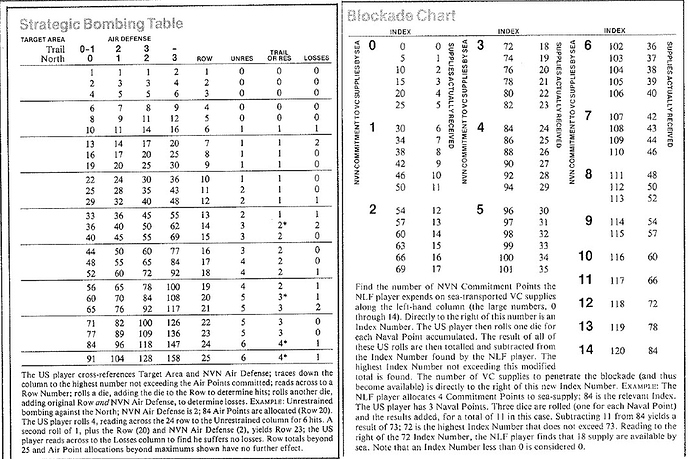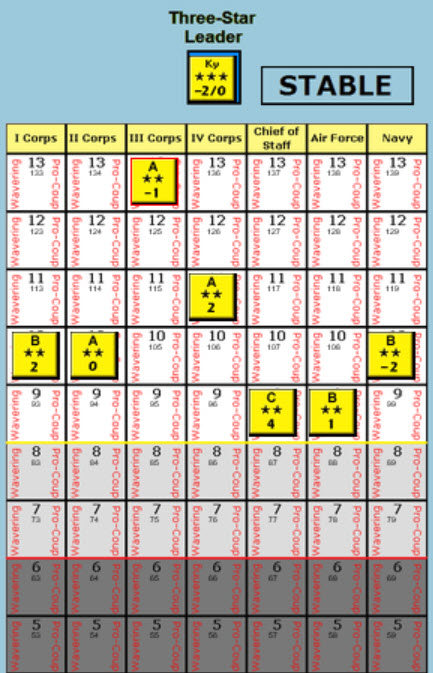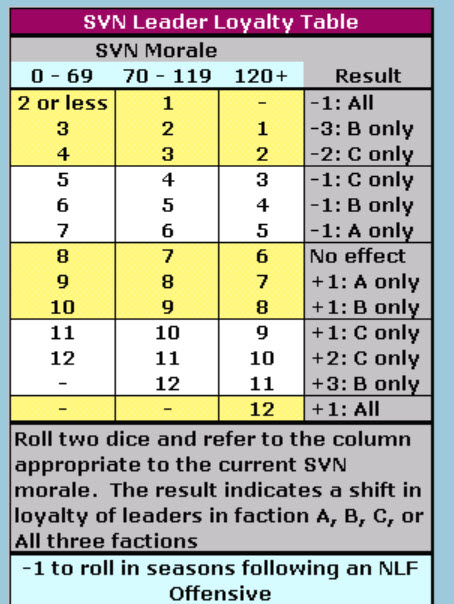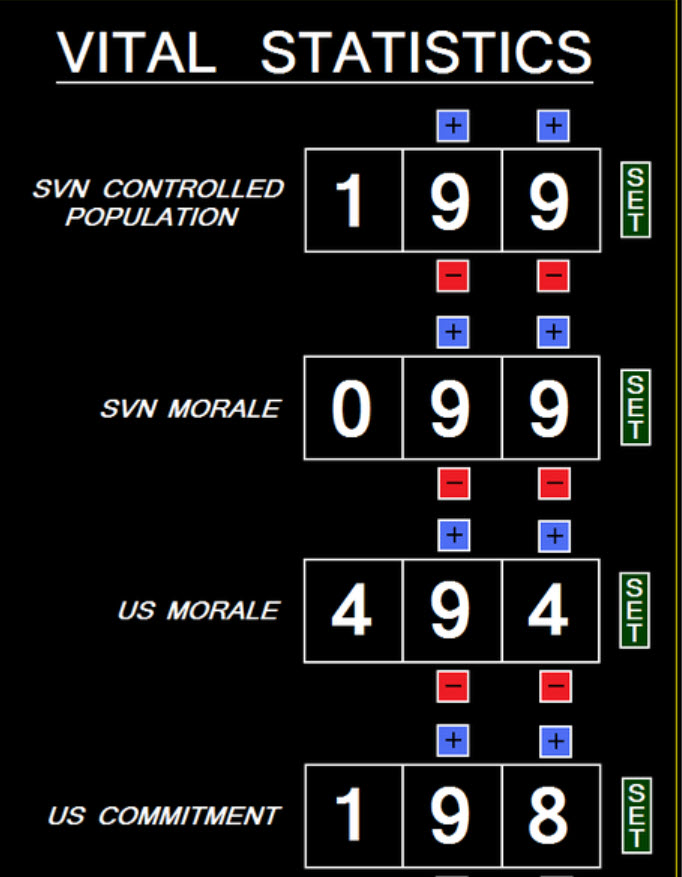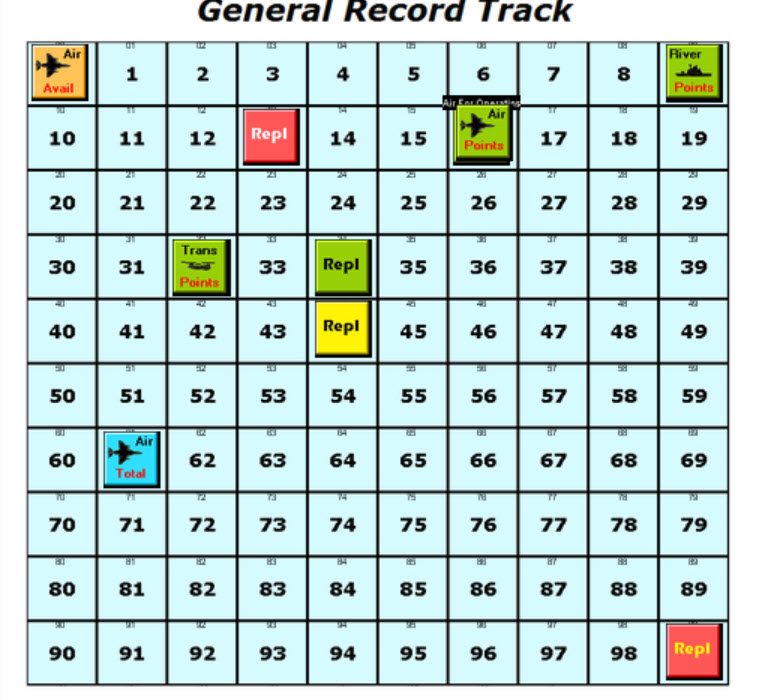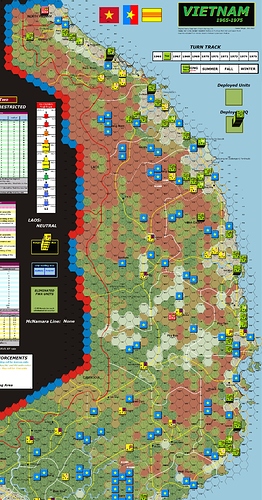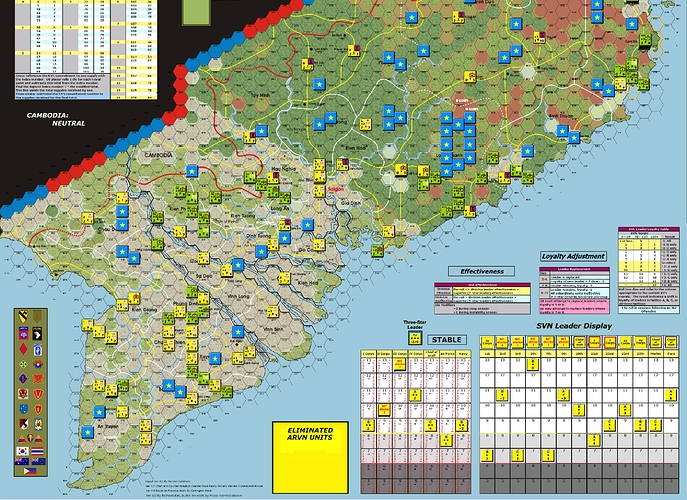Love Is Like an Itching in My Heart
Vietnam 1965-1975
1966 Spring Narrative, Interphase Exposition and Spring Interphase Resolution
“Love is like an itching in my heart, tearing it all apart. Just an itching in my heart and baby, I can’t scratch it.”
Put on your boogie shoes, get a drink (I recommend spirits), and then please hit play before reading and turn to the maximum volume your brain or household will allow.
The Supremes. “Love Is Like an Itching in My Heart.” Written by Holland-Dozier-Holland. Music by The Funk Brothers. Motown. Released April 8, 1966. In the Billboard 100 all through the Spring, finally peaking at Number 9 in May.
The Oval Office
In February 1966 President Johnson was discomfited by the situation in Vietnam. The military situation seemed to be progressing apace given the circumstances, but slower than he was comfortable with, politically.
Private conferences on February 20 with Bill Moyers and Jack Valenti, two trusted political aides, had made him uneasy. Both related that the situation in Vietnam might be causing murmurs in the Liberal Wing of the Democratic Party. Public support was solid, but certain party notables, Senators Fulbright and Kennedy among them, wanted a clearer vision expressed of how the country would ultimately end combat operations in South Vietnam. Certain elements in the Center and Right of the Democratic Party and the Republican Party were criticizing the limits imposed on US Forces in South Vietnam; the limits on troops committed, targets in North Vietnam, the apparent unfettered sanctuary allowed NLF forces in Laos and Cambodia. These weren’t a problem now but could be when the midterm elections approached. As well, the President was dismayed by CIA reports that indicated that the Soviets and Chinese were escalating assistance to the regime in Hanoi, matching US involvement with arms, money and technical assistance. The improvements to air defenses in North Vietnam and in certain segments of the Ho Chi Minh Trail in Laos and Cambodia by this aid were particularly concerning.
The President held an expanded multi-day conference, with Moyers and Valenti in attendance, beginning on February 23. Secretary of State Dean Rusk, Secretary of Defense McNamara, National Security Adviser McGeorge Bundy, and Deputy Director of Central Intelligence Richard Helms were all in attendance. The President laid out his vision; he wanted to cease bombing the North and offer to begin negotiations with North Vietnam in earnest. However, the situation in the South needed to be on the upswing, and the offer to begin negotiations needed to be seen as coming from a position of strength. How could he do this in the quickest way possible, hopefully before the Fall of 1966?
Secretary Rusk was of the opinion that a broader coalition of nations committed to the defense of South Vietnam would give the President leverage and bolster the image of strength, Internationally, in negotiations with the Communists. It certainly should move the Soviet Union and China to weigh in with Hanoi to accede to the President’s offer. The Republic of Korea had offered troops to aid in Vietnam, but Secretary McNamara interjected that the costs and logistical support for any South Korean troops would have to be borne by the United States. Secretary Rusk agreed but proffered that the Australian, New Zealand and Philippine Governments were vocally supportive of the US policy in Vietnam, and given a more robust commitment, may be induced to fulfill their SEATO obligations in defense of South Vietnam, and Thailand had also broached the idea of sending troops. Secretary McNamara assented regarding the the first three, but noted that any Thai commitment would require costs and logistical support similar to those required by South Korea. “This is great in concept, but we’ll have to provide the transport, support personnel and everything from razors to razor wire for these troops,” McNamara warned.
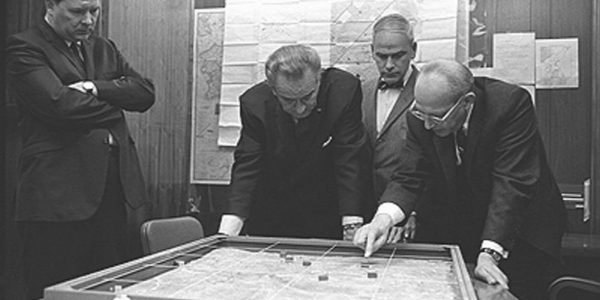
Deputy Director for Plans (CIA) Helms stated that the current population under South Vietnamese control probably fell in the Winter, based upon the latest reports, by 300,000, nearly double the decrease in the Fall. McNamara agreed, but indicated that this was to be expected; until the weight of the now complete US Army Combat Force had been felt operationally. “Look, we just sent three divisions there. Abrams needs time to actually conduct some operations on the ground to get those trends reversed.”, he countered to Helms, a little defensively.
“Bob, what do you need to make that happen quicker?”, the President inquired. McNamara indicated that support assets and firepower platforms could be accelerated in their deployment, and more aid provided to build up ARVN forces and capabilities. But he made clear that General Abrams required no additional ground forces for Operation Freedom Partner, though a request for an Armored Cavalry Regiment to serve as a trip-wire force near the DMZ was being considered. “Send it, and that other stuff too, Bob,” the President ordered. McNamara warned that this accelerated deployment could strain the resources of units in the United States, as well as those scheduled to rotate to Europe. “If it gets there sooner, Bob, it can start to get this thing around a corner, sooner. Might as well get the whole herd out of the stockade now if they are all heading out to range anyway.”
Ultimately the plan formulated was to accelerate all outstanding support and ground elements earmarked for South Vietnam immediately. As well, shipments of materiel to the ARVN would be ramped up. The President would formally ask the Australian, New Zealand and Philippine Governments to aid the United States in their mutual treaty obligations to South Vietnam. As well, the Republic of Korea and the Thai governments would be consulted regarding the possibility of dispatching military forces to South Vietnam. The bombing of the North would continue, but once the initial international “Free World Allies” (a term coined by Valenti) forces had arrived in South Vietnam, and once a positive trend in population under government control had been established, the President would travel to Asia or Australia and, with Allied leaders present, announce a bombing halt, and offer to begin negotiations with the North Vietnamese, offering an aid program and infrastructure development plan for the entire region as an incentive.
The COSVN Military-Party Committee
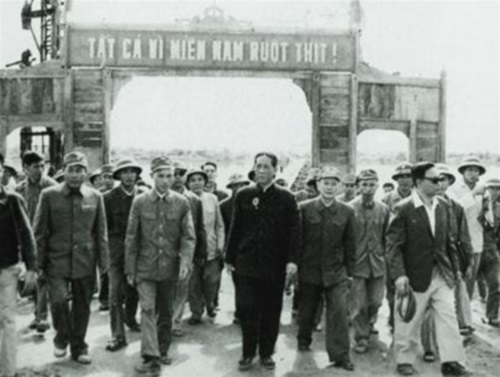
In January 1966 the COSVN Military-Party Committee convened a conference to examine the previous year and to strategize for the year ahead. To begin the conference analyzed the situation during 1965. The attention of those in attendance then turned to deducing the strategic military intentions and plans of the enemy. After careful contemplation the conference posited that the Americans and South Vietnamese would persist in 1966 with the basic strategic plan of 1965. That is to say, American and South Vietnamese units would aim to improve population security, attack and destroy Communist forces in South Vietnam, and magnify efforts against the recalcitrant North. Further, the conference surmised that this strategy was calculated to accomplish two goals: (1) counterattack and eliminate a significant chunk of the Communist main-force army, which would alter the balance of forces in favor of the allies and “on that basis regain the offensive initiative,” and (2) stress pacification to “gain control of our civilian population and our territory in the lowlands, in the areas around strategic military strong-points” and in Communist base areas.
After forecasting the enemy’s likely strategy, the COSVN Military Party Committee focused on developing the “strategic military plans and missions” for implementing the resolution passed down by the Twelfth Plenum of the Central Committee. Controversially, First Party Secretary Le Duan, Political Commissar of the Liberation Army of the South (COSVN Military Commander) Nguyễn Chí Thanh, and Party Secretary for Southern Military Affairs Nguyễn Văn Linh, representing the Aggressive War Faction, proposed as the strategic military plan laid out for 1966 an intensification of both guerrilla warfare and a “full, general uprising and offensive, designed to topple the criminal regime in the South and inflict severe casualties on the American Invaders”.
This contradicted the essential guidelines agreed to at the Twelfth Plenum, which called for Revolutionary War to continue, attempting to gradually increase areas under Party Control in the South. Betrayed, Minister of Defense General Giap, accused Le Duan of “herding us to disaster”. He, PAVN Chief of Staff General Văn Tiến Dũng, and Military Region Five Commander Hoàng Văn Thái opposed this strategy on two major grounds. First, there was insufficient Military Force in the South to capture any major cities or seriously challenge the Americans with serious losses. Yes, casualties could be inflicted, but insufficient PLAF Divisional formations, let alone PAVN forces, were in the South at present, making a general offensive, and the hundred attacks “by orphaned battalions” (a phrase used by Giap) required, a risky, bloody proposition. Secondly, they argued that conditions were insufficient to prompt a General Uprising. Population under Party control was steadily increasing, yes, but nowhere near to the level to support toppling the regime.
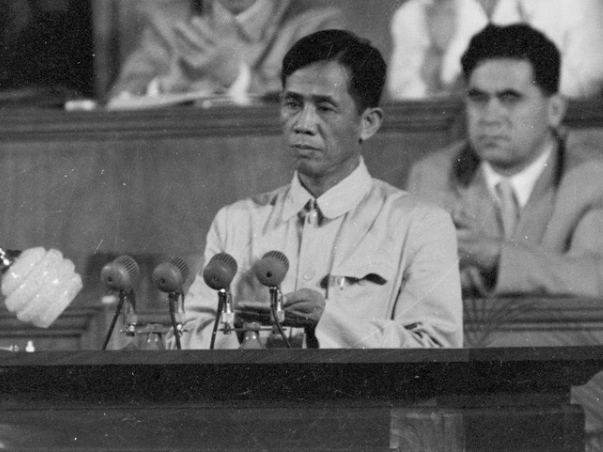
Le Duan countered, insinuating that the PAVN needed to “strengthen its dedication” to the revolutionary cause. The Aggressive War faction insisted that the first point was faulty, capturing provincial capitals would bring more population under Party control, and shake the morale of the criminal regime and its military. Freed of fear of oppression by the Southern Military Forces, and now in liberated zones, the population would rush to support Party Military formations. Secondly, if the former did not prompt a General Uprising, tit would certainly set the conditions for one in the next two or three months, given the rush of popular support and the paralysis and fall of the Ky Government that would follow. Finally, the US and Puppet Forces were stretched out, conducting offensive operations at the end of their supply lines, no positioned for defensive operations, and vulnerable to attack piecemeal.
“Piecemeal? Attacking with piecemeal battalions seems to even those odds. And the Americans,what about them?” countered Giap. “When their lackeys have collapsed, who will they support? They will leave.”, Le Duan responded calmly. This disagreement continued for a day, until General Dung, advised Giap to demure, and let the offensive play out. They were on record if it failed, but the Politburo would ultimately back Le Duan, and Ho would go along with the Politburo and First Secretary in the name of Party comity. A General Offensive and Popular Uprising would be launched, if supplies could be secured from the Socialist Brothers.
Concurrent with that undertaking, every effort would also be made to eradicate the U.S. military’s “main base of support for continuing the war” by shattering or causing the “disintegration” of the greater part of the ARVN and the collapse of the Saigon Government. With the “strategic military guidelines” for 1966 in place, the COSVN Military Party Committee conference proposed three “primary missions” to fulfill those guidelines. Collectively these missions reflected the broad agenda approved:
- Military:
• Attack and seize provincial capitals country wide, attacks would occur anywhere where a chance of succeeding could be established.
• Firmly hold and expand our base areas and liberate more people and more territory.
• Attack any US or Puppet formations which were judged to be out of supporting range of artillery.
• Annihilate between 30,000 and 40,000 U.S. troops and 200,000 puppet and satellite [allied] troops and to destroy 1,000 enemy aircraft of all types.
• Conduct powerful attacks against the enemy’s rear bases.
- Building Up Our Logistics Reserve Stockpiles: Not only provide sufficient supplies for 1966 but ensure that we have sufficient supplies on hand for 1967 as well.
The Strategic Military Planning Council of the Republic of Vietnam
On February 20, 1966, ARVN Chief of Staff General Cao Van Vien informed Prime Minister Ky and President Thieu that III Corps Commander Nguyen Bao Tri had been relieved for cause under his own authority, and presented evidence that General Tri had been selling supplies intended for Corps military forces under his command on the black market, leading to the ineffectiveness of his units. Ky was flabbergasted, as Tri was a patron of Ky’s and later claimed privately to associates that Vien exceeded his authority, but demurred comment at this meeting, in the face of the hard evidence against Tri. He was mollified somewhat by Vien’s suggestion that Tri be replaced by Major General Lê Nguyên Khang, Commander of the ARVN Marine Division, who had served well under Vien’s direct command and was known to have family associations with Ky. Khang would be replaced by Major General Do Cao Tri, a man of similar ability to Khang. Thieu, while not objecting to this at the meeting, was silently offended, as he had promised privately to ARVN 25 Division Commander Major General Nguyen Van Hieu that the next available Corps Command would go to him.
Discussing Operations for the upcoming Season, Vien urged that risks must be taken to continue to win back the countryside from the Communists. He urged that despite intelligence reports that the communists may be planning limited offensive operations, these preparations must be ignored, and all efforts made to destroy Communist units and clear populated provinces, a strategy and outlook he shared with General Abrams at MACV. Ky opposed this, and demanded that more defensive preparations be taken, more caution used. “If say, Pleiku or Dalat fall to some surprise attack, we’ll lose face with the population. That is as bad as having the people under the sway of the Viet Cong.” Vien countered with the statement, “In war, If you are reacting, you are doing exactly what the enemy want you to do.” Before the argument could grow particularly heated, President Thieu stepped in and suggested that Vien had coordinated with Abrams, the plan was a common plan, and that they should trust Vien’s experience and judgement.
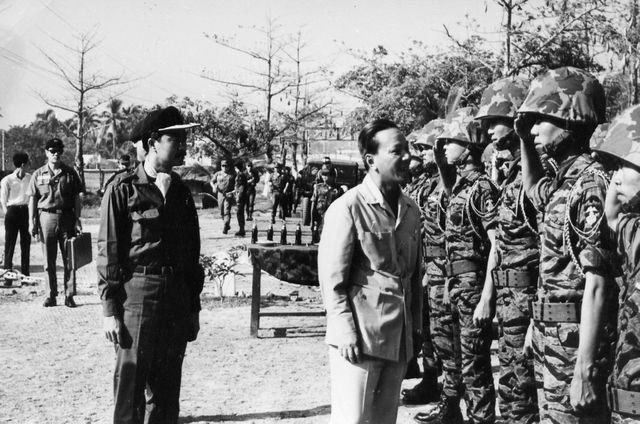
Regarding being passed over for the III Corps command, Major General Hieu took the matter in stride, but other Thieu loyalists within the Military were displeased with Ky’s favoring of family and patrons and the expense of Thieu’s associates. As well, the rift between Vien and Ky began to grow wider, as Ky took full credit for Khang’s promotion publicly, deepening their relationship, while privately discrediting Vien as an insubordinate “climber”.
In South Vietnam’s Provinces
The downward trend in the provinces continued to favor the communists but overall, the downward trend continued. A USAID and CIA estimate released February 1, 1966 indicated that the population under government control likely had fallen by 300,000 in the Winter, a decrease of 2.5%. Regardless, MACV, USAID and the Agency had confidence that the trend was reversing. However, any decrease in the current Offensive Operational tempo would see the trend remain static, and possibly continue its downward trend. Aggressive destruction of NLF units and the clearing of populated provinces must be given maximum effort, or the downward trend could be irreversible by the end of 1966.
Strategic War
Interdiction of convoys bound for the Trail were successful as well as bridges at intersections 5 and 24. However, crew reports indicate POL and industrial infrastructure targets are fully dispersed by NVN. As well, Air Defense Networks have been completed, likely partially crewed by PRC forces. Strikes are achieving diminishing returns given available means.
Cable from COM7THAIRFORCE to CINCPAC to February 10, 1966.
The newly-formed US Seventh Air Force and Task Force 77 launch nearly all available bombers against targets in North Vietnam. The Haiphong Railyards and Port were hit particularly hard again, as was Vinh’s seaport and industrial center and the city of Đồng Hới, targeting depots thought to house supplies headed south via sea and the Trail, respectively. The strikes were determined to be of limited effectiveness in degrading capabilities given the force applied, as continued North Vietnamese efforts to disperse vital POL stocks to smaller, hidden locations. A complete Air Defense network, of Chinese manufacture, and Chinese-manned, was now fully operational in Haiphong, Vinh, Dong Hoi, Hanoi and at Trail entrance hubs and collection stations. As well, the Trail was interdicted, with the Nape Pass and the Mụ Giạ Pass as primary targets. There were heavy aircraft losses and the strikes were determined to be minimally successful. Given the Spring monsoon, only a modicum of Aircraft would be available to support ground operations in South Vietnam. CINCPAC made clear to the SECDEF that, without additional air resources, strategic bombing would have minimal impact on the NLF military effort.
The increase of of new US Forces to South Vietnam in the Winter caused an uptick in US public reaction against US Involvement in Vietnam in the as Spring began. Protests at Private and Ivy League Universities expanded. A “Leave Vietnam Day” protest on February 22 occurred at 15 Universities nation-wide to include one at Dartmouth College in early February. On February 2, 1966 a Baltimore Quaker named Norman Morrison doused himself in kerosene and set himself on fire below Secretary of Defense Robert McNamara’s Pentagon office. This may have been in emulation of Thích Quảng Đức and other Buddhist monks, who burned themselves to death to protest the repression committed by the South Vietnam government. The event received major press coverage on the three major US Networks.
The resumption of US covert activities off the coast of North Vietnam, combined with the sharp increase in US Navy and Coast Guard assets patrolling South Vietnam’s coast deterred any serious effort by North Vietnam to send supplies by sea over the Winter. CIA reports indicated that supplies by sea reaching South Vietnam may have reached an all-time low, estimating that fewer than 50 tons may have been received by PLAF logistics units in South Vietnam via the ocean route.
International Politics
In Hanoi, the continued US bombings of the North, the successes of the Revolutionary War strategy and the large increase in US forces committed to South Vietnam in the Winter led the Soviet Union to increase its provision of military supplies to North Vietnam, to include massive increases in small arms and heavier weapons for the support of larger units, as well as finally providing S-75 Dvina (SA-2) Surface to Air Missiles which greatly bolstered the Air Defenses of both North Vietnam and the entrances to the Ho Chi Minh Trail. Chinese raw materials and petroleum products were available in larger quantities and the People’s Republic also began the provision of regular Air Defense troops to aid in manning North Vietnamese Air Defenses as well as providing other technical support to the PAVN and PLAF.
US Arrivals and ARVN Formations
In South Vietnam, on March 2, 1966 4 US Army Battalions of 175mm Howitzers arrived in Hue, followed by 6 US Army Battalions of 155mm Howitzers in Qui Nonh and Cam Ranh Bay on March 4. On March 6 the 11th Armored Cavalry Regiment arrived in Hue. The Royal Australian Regiment, departing from Darwin, arrived in Da Nang, Chu Lai, Qui Nonh and Cam Ranh Bay the first week of March, accompanied by the ANZAC Battalion, which also arrived in Da Nang. The Philippine Civic Action Group-Vietnam or PHILCAG-V arrived in Vung Tau on March 6. Five USAF squadrons of F-105Ds and 6 replacement battalions of US Army troops arrived in Bien Hoa, along with 7 Aviation Battalions-worth of UH-1D and CH-47 Helicopters. Equipment arrived in country to: outfit 8 ARVN Battalions-worth of replacement cadres; form and upgrade with the latest equipment the 21 ARVN Division in I Corps, with. As well, the United States Navy, in conjunction with the 1st Marine Division, began Operation Fast Water, deploying enough Assault Support Patrol Boats and PBRs to embark 9 USMC Battalions at any one time for operations, which arrived in Can Tho in late February and began organizing for Spring Operations in the Mekong Delta.
NLF Reactions
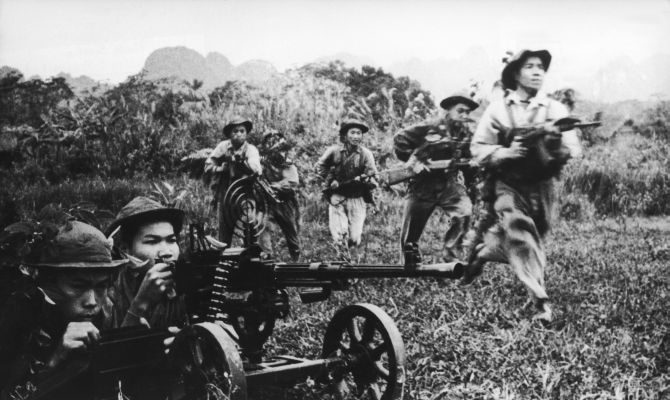
The Viet Cong appeared to increase its presence in I and II Corps, especially along the coastal plain, though there was an increased presence throughout South Vietnam near Provincial capitals. Replacement cadres surged into South Vietnam, according to intelligence reports from electronic listening posts near the borders of Cambodia and Laos, and the PAVN 274th Independent Regiment was reported 10 miles Southwest of Hau Bon, the eastern Regional Capital of Phu Bon Province. The NLF appeared ready to conduct offensive action this Spring, but where and to what extent remained the question.

It appeared that the ARVN Military Intelligence reports were accurate, an NLF Offensive seemed imminent, but how and where it would be conducted was a matter of debate at MACV. No Regimental or Divisional PLAF Units had been identified in the last Season, and the only PAVN presence in-country seemed to be the newly-arrived 274th Independent Regiment in II Corps. Abrams and Vien were of one mind though, clearing the areas under Communist control and the aggressive destruction of NLF Forces in populated areas had to be the first priority, even if attacks were launched. NLF Attacks would be used as an opportunity to bleed the NLF, sapping their reserves and aiding the ultimate goal of reversing Pacification trends. But how much were the MACV and ARVN Commanders willing to sacrifice? “I don’t care that much about Real Estate on the small scale,” Abrams told Major General Weyand, the Commander of the Americal Division. “And I don’t think Cao [General Vien] does either. But Prime Minister Ky, might. And my bosses too.”
Interphase Resolution (and Exposition)
Please take a deep breath, get up, stretch, hit play before reading and turn to the coolest, punchiest volume your brain or household will allow.
The Beatles. “Rain”. Parlophone-Capitol. Released May 30, 1966. Peaked at Number 23 on the Billboard 100 in June 1966. B-Side to the single “Paperback Writer”.
A Little Discussion about Spring, Monsoon, 150 Commitment and NLF Offensives
If the song had been Season-appropriate, I might have chosen “Two Trains Running”.
“Two Trains Running, on that same line, one train is me and the other a friend of mine”.
So beginning this Interphase and the next three or four Seasons, we are now seeing the first climax of this game. First, we have the “full” core Ground Allied force in country. Secondly, commitment, currently at 148, will likely exceed 150 this Interphase. That means the NLF could declare an offensive for 10 NVN Commitment this season. That means he will get to inflict -4 to US Morale for the first 30 attacks (each attack, meaning each round. No matter how crappy, or how disastrous it is). After that, for every 3 attacks, the NLF would get -1 to US Morale.
The US is currently strung out, spread out to conduct aggressive offensive operations and not ready for this. Curt could conceivably get 100+ attacks in (???) if he does one. Unless I go turtle and defensive, and spend my energy and operations shutting him down.
Also, my Airmobile and available air points will be reduced by 25% because of the monsoon season. This makes an offensive even more attractive. So I have 3 commitment choices. Don’t go over 150. Creep over 150. Go big and just skyrocket in with 50 Commitment this Season up to 198 Commitment.
There’s no choice, 198 Commitment it is.
Because in my opinion, I have only one Strategic choice. I have to let him pound my morale and use all my efforts for the my offensive actions this Season. Because Pacification is low. And as you’ll see, it gets lower, going down by -7 from 206 to 199. So if he declares an offensive, I need to bleed him when he attacks, and when he is exhausted, counterattack until I have used every shot in my locker. Because, never mind US Morale, if Pacification continues to sink, I could lose this thing based on an irreversible negative Pacification trend.
And Curt? Well, I am strung out and vulnerable to many, many attacks, but he doesn’t have a lot of stuff to really fight me. Just a lot of VC Battalions. No NVA and VC Divisions, to use to really bring the hammer down on me on some selective big attacks that really cause serious casualties and/or guarantee that he can roll up a large haul or Provincial Capitals and big cities. And if he does this, he’ll possibly be sacrificing his Pacification gains, because if I hit him hard this Season during the Offensive, Well, I will very likely hurt him even worse next Season. So he very well, may be sacrificing Pacification gains for a result, that yes, may hurt me, but not hurt me like Tet 68 hurt the US historically.
I use this as a point of comparison because it was the first Offensive of this type the Communists launched in the war. So it bears comparison to our situation. If Curt launched one, this will be the first Offensive of this type. And I , as the Americans then, am strung out, straining to take the offensive. But there are serious differences. The US had (in Game terms) 340 Commitment and 410 morale (I’ll have 198 and 494 respectively). Historically, Tet was probably four times larger than anything Curt can pull off this Season and forced the US to reduce Commitment involuntarily to get it below Morale in game terms. I am nowhere near doing that, and don’t plan to be. Westy had 9 US Divisions in South Vietnam when Tet happened. I have Four. And really don’t plan to bring any more. Firepower? Absolutely. Support? As needed. Maybe some FWA units? Sure. But this is my force profile. Four US Divisions and two Brigades. That’s it. I want the US to be a viable player on the ground well past 1970.
So this Season and the next two or three, to paraphrase and garble Churchill, aren’t the beginning of the end, or even the beginning of the middle. But when we’re done, I guarantee you, we’ll have seen the End of the Beginning.
Whew, after all that, I am gonna Cheat. We need another song. We’ll do a Beatles Double-Shot today. One of my all time faves.
The Beatles. “Paperback Writer”. Parlophone-Capitol. Released May 30, 1966. Peaked at Number 1 on the Billboard 100 for two weeks June 1966. A-Side for “Rain”.
I and II Corps at Interphase Beginning
III and IV Corps at Interphase Beginning
Vital Statistics
Recordkeeping Phase (an ongoing Process)
Pacification Phase
-7. Average rolls. Down to 199, like I said.
Strategic War Phase
A. Mission Declaration Segment: I declare what I want to bomb, North Vietnam (Restrained or Unrestrained) and/or the Trail and how many Air Points I allocate. I allocate 40 of my 49 to Pound the North Unrestrained and Unflinchingly. Munich, Hep-Cat. This is a War, not a spurious negotiation theory. I allocate 8 against the trail. That’ll leave 1, unless I bring more. And it’s Monsson, so what’s left will be -25% for Ops.
B. Strategic Bombing Segment: one NVN Air Defense built. A Trail Improvement has been made so his optimal is now the “6” box. Rolled a 3 for 40 Air Points conducting Unrestrained Bombing of the North. You take the number of Air Points and cross reference to the Row that corresponds with it given the low (‘0”) NVN Air Defense Levels at present. That’s row 14. I rolled a 3. Row 17. 4 Commitment destroyed. 2 NVN Commitment lost. Then I rolled a 1d6/2 (rounded down) +1 for its harm to US Morale. Rolled a 3/2=1+1, -1 Morale. Curt then rolls a d6 starting at row 15 (+1 to the row for air defense of 1) and rolls a 6. Row 21. 2 Air losses. Ouch! . SVN Morale gets boosted +4 to 92. Then I roll for 8 Air points against the Trail (which is fragile, 1 hit, and he goes from 10 supplies per commitment point to 9 per). I am on Row 5. Whatever I roll will do 1. I hit the Trail, degrading it. . Curt then rolls a d6 starting at row 6 (+1 to the row for air defense of 1) and rolls a 6. Row 12. 1 Air losses. Ouch! .
C. Blockade Segment: 0 NVN Commitment was sent. That puts him on row 0. I have 2 Naval Points now. Threat trumped effect. Bye Bye Sea Supply.
D. Trail Status Segment: Status is one below optimal. Dinged.
Before:
After:
Politics Phase
A. SVN Officer Replacement Segment: I must attempt to Mr. Incompetent and Absolutely Disloyal in III Corps. I succeed on a 6. I draw an A -1, with a 13 Loyalty. Incompetent, but very loyal.
B. Coup Determination Segment: You roll 2d6 and compare it to the Two Star Loyalties. If the roll is less than their loyalty, they are Loyal. Same as their Loyalty, they are Wavering. Greater than their loyalty, they are Pro-Coup.
If there are more Pro-Coup Leaders than Loyal Leaders, there is a Coup. The Three Star gets put back in the Three Star pull and a new one is randomly pulled (it could be the same guy). The loyalty of every Loyal Two-Star Leader goes down by one. The US takes a -3 Morale hit and the SVN take a -8 Morale hit. Coups are bad.
If the Wavering and Pro-Coup Leaders combined are equal to the Loyal Leaders, the Government is Unstable. The US takes a -1 Morale hit and the SVN take a -3 morale hit. Unstable sucks.
If the Loyal Leaders Outnumber Wavering and Pro-Coup Leaders combined, the government is Stable. Lower the Loyalty of Pro-Coup Two Star Leaders by 1.
I rolled a “5”! Yay! The Coup monster has been staved off. Thank God. If there is an offensive, I’ll need the ARVN.
C. SVN Morale Adjustment Segment: You implement and calculate all the Morale adjustments for the SVN first. I am at 92 (up 4 from the Unrestrained Bombing of the North). -2 for KY and -1 for Population level and then a great +10 for the 20% of new US Commitment last Season 50, 10). 99 morale. This is good. But I still don’t feel Coup/Unstable-proof level.
Leader Loyalty Adjustment Roll-Now I roll on this table to see what wackiness happens with the ARVN Factions:
I roll, a 5! All B’s -1. Damn that Thieu faction! The ARVN just keep slipping down on loyalty…
D. US Morale Segment: we already went down to 502 from 504 because of the Strategic Bombing. Now we are: -7 for US New Commitment of 50. -1 for US Commitment 148. -8 total. US Morale 494.
E. NVN Morale Adjustment Segment: They go from 49 to (+6 if Morale below 41-70, because they are dedicated communist revolutionaries (Yadda Yadda Yadda), +12 for US Commitment 126-150 and +10 (like SVN) for US New Commitment last season. New Morale, 77.
A. US, ARVN and FWA Placement and Withdrawal Segment
Withdrawals come before Placements. Anything Withdrawn can’t be placed that same segment.
US
US Withdrawals
None
US Placements
18 US Replacements (6C)
15 Air Points (5C)
14 Airmobile Points (7C)
9 Riverine Points (9C)
56 ARVN Supply (8C)
11 Armored Cavalry Regiment (3C) in Hue. I’ll discuss my plans for them later.
6 155 Battalions (6C) II Corps
4 175 Battalions (6C) I Corps
Firepower!
Royal Australian Regiment, ANZAC Battalion and Philippine CAG placed in II Corps Ports and Da Nang and Chu Lai. They are free deployments when US Commitment exceeds 160. I plan to use them as garrison forces in selective locations.
ARVN
Withdrawals:
None
Builds:
56 ARVN Supply (8C) Build 2 ARVN Rangers (10P/18S), ARVN 21 Div in I Corps (4P/21S), 2 CAV (2S) in order in I Corps, 16 Replacement Points (4P/8S)
End: ARVN Draft – 85, 1 Supply.
For the ARVN Armored Cav I Built: 2 ARVN CAV in Hue, leader pulled – B -2. Forget them. Next 3 division CAV in Hue, 7 in Hue, he sucks too, forget him, 21 division in hue, keeper, a B 7. 4S. That is why I then built up the ARVN 21 Division.
B. NVA and VC Placement: Curt places a lot of stuff I can’t see. What I do see are +87 VC Replacements which means there will be an NLF Offensive.
C. Infiltration Segment: Nothing
D. Offensive Declaration Segment: Costs 10 NVN Commitment and can only occur if US Commitment is 150 or higher. Curt declares one and places a free NVN Regiment in Phu Bon (included for the NLF with the cost of the Offensive).
Curt sends file to me, I start a Vlog to record one roll to basically complete this diary entry.
A. US Organizational Segment: I can alter my Brigades’ deployment Profile if all elements are stacked together. I do not.
B. ARVN Effectiveness Roll: I roll 1d6 On the below table and compare with my current Leaders. This is the big enchilada, who can do what for the next two loooong game turns of Summer ’65 for the ARVN.
Also, I have to roll less than or equal to a Corps commander’s rating +3 or all those independent Battalions in his Corps area are Ineffective. Ineffective means they basically can’t move and do nothing all Season.
I roll a 4. I’ll take it. Only II and III Corps units (no one but Corps Assets at present) ineffective. All my Divisions and I and IV Corps Assets and the Chief of Staff units are effective.
Vital Stats at Interphase End
Support at Interphase End
I and II Corps at End of Interphase. NLF Increases near all provincial capitals. Increases on the Coastal Plain.
III and IV Corps at End of Interphase. Not much of a III Corps increase, but he has a lot there now anyway. A slight uptick in IV Corps for the attacks to come.
“If the rain comes they run and hide their heads. They might as well be dead. If the rain comes.”
Next: The End of the Beginning
By the way, if anyone has any questions about the game or the narrative: rules, why who did what, what’s happening in the History, stuff about the music, really anything, feel free. It won’t disturb or “clutter” anything, and the initial post will be updated with bookmark quick links from time to time. I’m happy for this to be an interactive, discursive experience. If I wanted this diary chiseled on impenetrable stone, I would have blogged it. Talking about stuff here, well, it’s fun.
